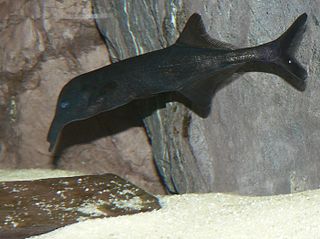
African tetras are a group of characiform fish found exclusively in Africa. This family contains about 18 genera and 119 species. Among the best known members are the Congo tetra, and African tigerfish.

Thoracochromis is a fish genus of haplochromine cichlids that are endemic to Africa. Most species are from rivers in Angola and Namibia, or the Congo River Basin in Central Africa, but T. wingatii is from the Nile system. Additionally, there are a few apparently undescribed species from the Nile system, which appear to be close relatives of T. wingatii or Haplochromis loati. Many species have been moved between this genus and Haplochromis, and while some consensus has been reached in recent years, their mutual delimitation is still far from settled.

Tilapia is a genus of cichlid fishes endemic to freshwater habitats in Southern Africa. In the past this was a very large genus including all species with the common name tilapia, but today the vast majority are placed in other genera.

Synodontis is the largest genus of mochokid catfishes. It is the biggest genus within the 10 genera and 190 different species in the family Mochokidae. Synodontis has over 131 different species within the genus. Synodontis are also known as squeakers, due to their ability to make stridulatory sounds through their pectoral fin spines when handled or disturbed. Synodontis make a sound that sounds like squeaking by rubbing their spines together. They do this when they have been frightened or when they become angry. Synodontis may also squeak when they are taken out of the water. These catfish are small- to medium-sized fish with many species exhibiting attractive spotted markings. Some species are also known for naturally swimming belly-up, earning the name upside-down catfish. Some of these species are Synodontis contractus and Synodontis nigriventris. While some of these species are known to swim upside down, another species, Synodontis multipunctatus, is a brood parasitic cuckoo catfish,there are two other species Synodontis petricola and Synodontis grandiops are also called brood parasitic cuckoo catfish.

Haplochromis is a ray-finned fish genus in the family Cichlidae. It has been used as the default "wastebin taxon" for Pseudocrenilabrinae cichlids of the East African Rift, and as such became the "largest" fish "genus". Many of these cichlids are popular aquarium fishes; like similar Haplochromini they are known as "haplos", "happies" or "haps" among aquarium enthusiasts.

Albulidae is a family of fish, commonly known as the bonefishes, that are popular as game fish in Florida, select locations in the South Pacific and the Bahamas and elsewhere. The family is small, with 11 species in 3 genera. Presently, the bonefishes are in their own order: Albuliformes. The families Halosauridae and Notacanthidae were previously classified in this order, but are now, according to FishBase, given their own order Notacanthiformes. The largest bonefish caught in the Western Hemisphere is a 16-pound, 3 ounce example caught off Islamorada, Florida, on March 19, 2007.

Chiloglanis is a genus of upside-down catfishes native to Africa. These species have modified lips and barbels that form a suckermouth. They also have a naked (scaleless) body. Sexual dimorphism has been reported in Chiloglanis. The adult males of many of these species have elongate anal and caudal fins. Also, males may have an enlarged humeral process.
Hypsopanchax is a genus of poeciliids native to freshwater habitats in Middle Africa.
Kneria ruaha is a freshwater species of fish in the genus Kneria endemic to Tanzania. It naturally lives in rivers.

Kneria is a genus of small fish in the family Kneriidae. All the species in this genus are restricted to Africa.
Kneria rukwaensis is a species of fish in the family Kneriidae endemic to Tanzania. Its natural habitat is rivers.

Kneria uluguru is a species of fish in the family Kneriidae endemic to Tanzania. Its natural habitat is rivers.
Parakneria spekii is a species of fish in the family Kneriidae. It is endemic to Tanzania. Its natural habitat is rivers.
Parakneria tanzaniae is a species of fish in the family Kneriidae. It is endemic to Tanzania.

The Kneriidae are a small family of freshwater gonorhynchiform fishes native to sub-Saharan Africa.

Parakneria cameronensis is a benthopelagic species of tropical fish. The species can grow up to 8.3 cm, and are commonly found in the Congo River. The fish has a projectile upper jaw and subterminal mouth. The species' common name is Cameroon shellear.
Clypeobarbus is a genus of small cyprinid fishes native to Africa. Most species are restricted to the Congo River Basin, but C. pleuropholis is also found in the Chad Basin, while C. bellcrossi is from the Zambezi and C. hypsolepis is from rivers in Western Africa.

Campylomormyrus is a genus of elephantfish in the family Mormyridae.

Poropanchax is a genus of small poeciliid fishes native to Africa.

Enteromius is a genus of small to medium-sized cyprinid fish native to tropical Africa. Most species were placed in the genus Barbus.












